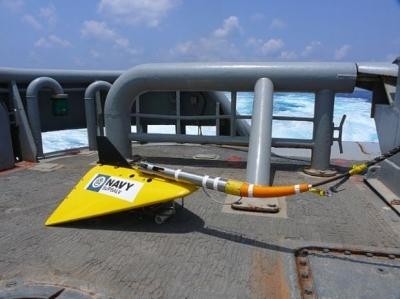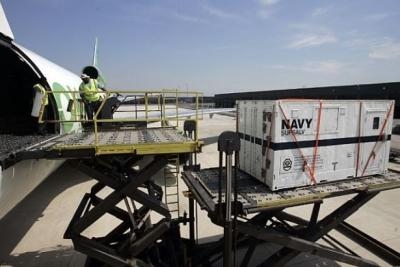Wed, Mar 26, 2014
Towed Array Listening Device Deployed To Search Area In The Indian Ocean
The U.S. Navy is continuing efforts to search for missing Malaysian Airlines flight MH370. As a precautionary measure in case a debris field is located, U.S. Pacific Command ordered U.S. Pacific Fleet to move a black box locator into the region March 24.

If a debris field is confirmed, The Navy's Towed Pinger Locator 25 will add a significant advantage in locating the missing Malaysian aircraft's black box.
The TPL-25 Towed Pinger Locator System is able to locate black boxes on downed Navy and commercial aircraft down to a maximum depth of 20,000 feet anywhere in the world. Commercial aircraft pingers are mounted directly on the flight recorder, the recovery of which is critical to an accident investigation. The Pinger Locator is towed behind a vessel at slow speeds, generally 1-5 knots, depending on the depth. The tow array carries a passive listening device for detecting pingers that automatically transmit an acoustic pulse.
"In the event a debris field is located, we're moving some specialized locator equipment into the area. The Towed Pinger Locator has some highly sensitive listening capability so that if the wreck site is located, we can hear the black box pinger down to a depth of about 20,000 feet. Basically, this super-sensitive hydrophone gets towed behind a commercial vessel very slowly and listens for black box pings," said Cmdr. Chris Budde, U.S. 7th Fleet operations officer.

"This movement is simply a prudent effort to preposition equipment and trained personnel closer to the search area so that if debris is found we will be able to respond as quickly as possible since the battery life of the black box's pinger is limited," said Budde.
If found, the acoustic signal of the pinger is transmitted up the cable and is presented audibly, and can be output to either an oscilloscope or a signal processing computer. The operator monitors the greatest signal strength and records the navigation coordinates. This procedure is repeated on multiple track lines until the final position is triangulated.
The system consists of the tow fish, tow cable, winch, hydraulic power unit, generator, and topside control console.
Most pingers transmit every second at 37.5 kHz, although the TPL can detect any pinger transmitting between 3.5 kHz and 50 kHz at any repetition rate.
(Images provided by the U.S. Navy)
More News
“We respectfully call on the City of Mesa to: 1. Withdraw the landing fee proposal immediately 2. Engage with the aviation community before making decisions that impact safet>[...]
High Speed Taxiway A long radius taxiway designed and provided with lighting or marking to define the path of aircraft, traveling at high speed (up to 60 knots), from the runway ce>[...]
Aero Linx: International Federation of Airworthiness (IFA) IFA uniquely combines together all those with responsibility for policies, principles and practices concerned with the co>[...]
Controller’s Expectation That VW02 Would Have Departed Sooner Led To An Inadequate Scan And Loss Of Situational Awareness Analysis: A Robinson R-44 helicopter N744AF, VW02 (V>[...]
A Few Questions AND Answers To Help You Get MORE Out of ANN! 1) I forgot my password. How do I find it? 1) Easy... click here and give us your e-mail address--we'll send it to you >[...]
 Aero-News: Quote of the Day (12.09.25)
Aero-News: Quote of the Day (12.09.25) ANN's Daily Aero-Term (12.09.25): High Speed Taxiway
ANN's Daily Aero-Term (12.09.25): High Speed Taxiway ANN's Daily Aero-Linx (12.09.25)
ANN's Daily Aero-Linx (12.09.25) NTSB Final Report: Diamond Aircraft Ind Inc DA20C1 (A1); Robinson Helicopter R44
NTSB Final Report: Diamond Aircraft Ind Inc DA20C1 (A1); Robinson Helicopter R44 ANN FAQ: Q&A 101
ANN FAQ: Q&A 101




